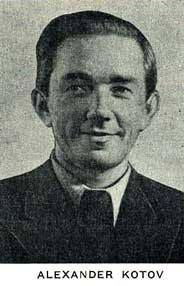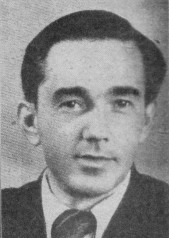Alexander Kotov
Alexander Alexandrovich Kotov (Russian Александр Александрович Котов; * 30 Julijul / August 12 1913greg in Tula, .. † January 8, 1981 in Moscow) was a Soviet chess master.
Chess career
For its first participation at the national championship of the Soviet Union in 1938 Alexander Kotov took surprising second place behind the eventual world champion Mikhail Botvinnik. During the Second World War he worked in the defense industry and was awarded for the construction of a grenade launcher the Order of Lenin.
In the 1950s, he was one of the best players of the Soviet Union and won, among others, the Interzonal in Stockholm 1952. In this tournament, its result of 16.5 out of 20 ( = 82.5 %) meant the record in Inter-Zone Tournament (as of 1981). In 1958 he took part in a USSR championship for the last time. In 1962, he won, shared with Svetozar Gligorić, the tournament in Hastings. In 1967 he was second behind Lajos Portisch the IBM tournament in Amsterdam.
His best historical Elo rating was 2753 in April 1950, that he was number 4 in the world rankings.
Due to his international success, he received in 1950 by FIDE the title of Grand Master.
There are several chess puzzles from a Alexander Kotov, but they come from the namesake Alexander Ivanovich Kotov.
Scripture Combinatorial activity
Kotov wrote several important chess books, including a two-volume biography of Alexander Alekhine, published 1953-1958, and Think like a Grandmaster (1970) and Play Like a Grandmaster (1978), in which he discusses the technique of variant calculation in chess. In addition, he wrote in 1951 (together with Mikhail Petrovich Judo ) the work of chess in the USSR, in which the achievements of the Soviet chess school are presented. He also wrote a detailed book on the " International Chess Tournament 1950 Venice " ( FiS, 1952), which he won against Smyslov.
Kotows brilliant game against Averbakh
His most famous game played in the Candidates Tournament Kotov Zurich 1953. Against Averbakh he managed a spectacular queen sacrifice that led to the game winning by 21 other trains.
After an Old Indian opening the position was reached in diagram 1 after 30 Awerbachs train. The position carries royal Indian features, the center is locked, Black has achieved with the pawn advance f7 - f5 - f4 space advantage on the kingside without that white has initiated the setting contemporary counterplay on the queenside. The confined character position to the white king favors the following Into draw victims:
" When was this train happen, a powerful murmur went through the [ ... ] tournament hall, and on the faces of the two fighters was a clear smirk determine ". The white king is hampered by its own tower on g2, the pawn on f4 covers the field g3, according to the following trains white must necessarily " meet " the Black:
34 tg7 Rf8 35 K g4 Kxg7 36 Tg1 Rg8 37 Kf5 Kf7 38 Txg8 T5 plus matt
Kotov subsequently repeats the train to reach the time of control.
Subsequent analyzes showed that Th1 44th most resists.
White gave up ( see diagram 2), it threatens T6 matt, why Averbakh would have to give the lady and Kotov wins clear the resulting endgame.
Kotov Syndrome
In his book Think like a grandmaster ( Russian original edition 1970) he describes a typical behavior in chess, which became known as Kotov Syndrome. Here, a player thinks long hard after several alternatives for his next train, but is no clear decision. Once the waiting period is scarce, he plays an impromptu train, he has not calculated and often turns out to be bad. As a metaphor, the term is now also used outside of chess. On the album Appeal to Reason of the band Rise Against you find a song with the title " Kotov Syndrome".




.jpg)





